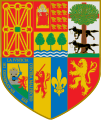File:Zazpiak Bat.svg

Size of this PNG preview of this SVG file: 504 × 600 pixels. Other resolutions: 202 × 240 pixels | 403 × 480 pixels | 645 × 768 pixels | 860 × 1,024 pixels | 1,721 × 2,048 pixels | 579 × 689 pixels.
Original file (SVG file, nominally 579 × 689 pixels, file size: 1.38 MB)
File history
Click on a date/time to view the file as it appeared at that time.
| Date/Time | Thumbnail | Dimensions | User | Comment | |
|---|---|---|---|---|---|
| current | 20:42, 30 April 2009 |  | 579 × 689 (1.38 MB) | SanchoPanzaXXI~commonswiki | retoque lobos |
| 18:31, 30 April 2009 |  | 579 × 689 (1.39 MB) | SanchoPanzaXXI~commonswiki | rediseño | |
| 19:52, 28 November 2007 |  | 550 × 650 (384 KB) | SanchoPanzaXXI~commonswiki | {{Information |Description={{en}}Modern version of en:Zazpiak Bat insignia. From the Basque words zazpiak meaning "the seven ones" and bat meaning "one", translates as "the seven ones [are] one", refers to the seven historical Basque Country territor |
File usage
The following pages on the English Wikipedia use this file (pages on other projects are not listed):
Global file usage
The following other wikis use this file:
- Usage on ar.wikipedia.org
- Usage on bs.wikipedia.org
- Usage on ca.wikipedia.org
- Usage on da.wikipedia.org
- Usage on en.wikiversity.org
- Usage on eo.wikipedia.org
- Usage on es.wikipedia.org
- Euskal Herria
- Escudo de Navarra
- Usuario:Keat
- Usuario:Ultrasiete
- Usuario Discusión:Martiko
- Wikiproyecto:Euskal Herria
- Wikiproyecto Discusión:Euskal Herria
- Wikiproyecto:Euskal Herria/Userbox2
- Usuario:Tximist
- Usuario:Ignaciojd3
- Usuario:Zarateman
- Usuario:Janfri
- Zazpiak Bat
- Usuario:Rikku~eswiki
- Usuario Discusión:Tximist
- Wikiproyecto Discusión:Euskal Herria/Discusiones2
- Portal:Navarra/Portales Relacionados
- Portal:País Vasco
- Portal:País Vasco/Portales relacionados
- Inmigración vasca en Chile
- Usuario:Marine13
- Usuario:El-Numero
- Xabi Aburruzaga
- Usuario:Pablitop
- Usuario:Aberzale
- Usuario:Igalix/Archivo de 2007-2010
- Usuario:Userbox/Localización/España
- Usuaria:Userbox mujer/Localización/España
- Koruko Ama Birjinaren Eskola
- Usuario:Raulsalvatierra1998
- Usuario:Sejuzu
- Jean de Jaurgain
- Armorial de las familias vascas
- Usuario:Gogoter
- Usage on eu.wikipedia.org
View more global usage of this file.

